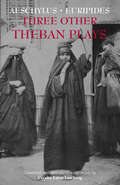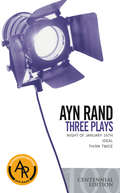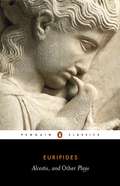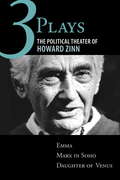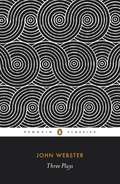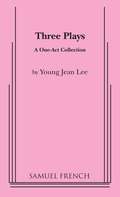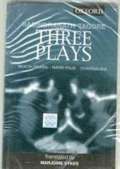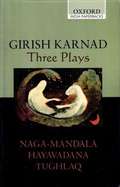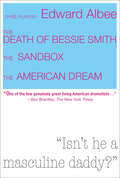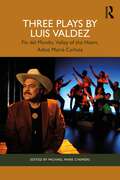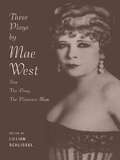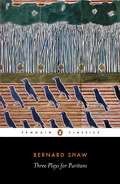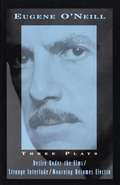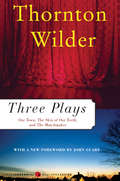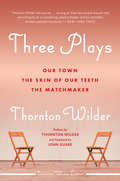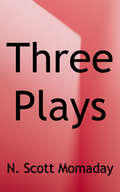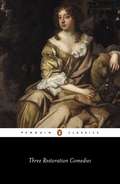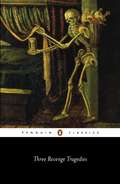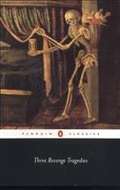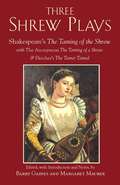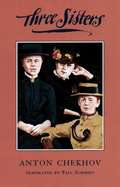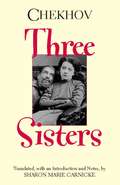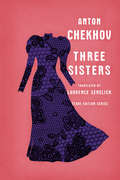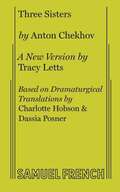- Table View
- List View
Three Other Theban Plays: Aeschylus' Seven Against Thebes; Euripides' Suppliants; Euripides' Phoenician Women
by Aeschylus EuripidesThough now associated mainly with Sophocles' Theban Plays and Euripides' Bacchae, the theme of Thebes and its royalty was a favorite of ancient Greek poets, one explored in a now lost epic cycle, as well as several other surviving tragedies. With a rich Introduction that sets three of these plays within the larger contexts of Theban legend and of Greek tragedy in performance, Cecelia Eaton Luschnig’s annotated translation of Aeschylus' Seven Against Thebes, Euripides' Suppliants, and Euripides' Phoenician Women offers a brilliant constellation of less familiar Theban plays—those dealing with the war between Oedipus’ sons, its casualties, and survivors.
Three Plays
by Ayn RandPublished together for the first time are three of Ayn Rand's most compelling stage plays. The courtroom drama Night of January 16th, famous for its open-ended verdict, is presented here in its definitive text. <P><P>Also included are two of Rand's unproduced plays, Think Twice, a clever philosophical murder mystery, and Ideal, a bitter indictment of people's willingness to betray their highest values-symbolized by a Hollywood goddess suspected of a crime.
Three Plays
by EuripidesOne of the greatest playwrights of Ancient Greece, the works of Euripides (484-406 BC) were revolutionary in their depiction of tragic events caused by flawed humanity, and in their use of the gods as symbols of human nature. The three plays in this collection show his abilities as the sceptical questioner of his age. Alcestis, an early drama, tells the tale of a queen who offers her own life in exchange for that of her husband; cast as a tragedy, it contains passages of satire and comedy. The tragicomedy Iphigenia in Tauris melodramatically reunites the ill-fated children of Agamemnon, while the pure tragedy of Hippolytus shows the fatal impact of Phaedra's unreasoning passion for her chaste stepson. All three plays explore a deep gulf that separates man from woman, and all depict a world dominated by amoral forces beyond human control.
Three Plays
by Howard ZinnWorld-renowned historian Howard Zinn has turned to drama to explore the legacy of Karl Marx and Emma Goldman and to delve into the intricacies of political and social conscience perhaps more deeply than traditional history permits. Three Plays brings together all this work, including the previously unpublished Daughter of Venus, along with a new introductory essay on political theater, and prefaces to each of the plays.From the Trade Paperback edition.
Three Plays
by John WebsterThe plays of Jacobean dramatist John Webster are masterpieces of early seventeenth-century English theatre. ‘The White Devil’ depicts a dark, sinister world of duplicity, intrigue and murderous infidelity, while ‘The Duchess of Malfi’ tells the macabre story of a woman who marries beneath herself and sets in motion a terrible cycle of violence. Unlike these revenge tragedies, ‘The Devil’s Law-Case’ asserts social order in a plot filled with twists of fate. Written at a time when the court of King James was rife with instability and corruption, Webster’s disturbing plays reflect this abuse of power and are known for their horrific vision of humanity – yet they are also some of the most rich, sophisticated dramas ever composed.
Three Plays
by Young Jean LeeYoung Jean Lee, OBIE award-winning playwright and director who has been called "the most adventurous downtown playwright of her generation" by The New York Times and "one of the best experimental playwrights in America" byTime Out New York, presents her early work in this collection of three one-acts. Included in this collection are: The Appeal, Groundwork of the Metaphysic of Morals, Pullman, WA
Three Plays Mukta-Dhara - Natir Puja - Chandalika
by Rabindranath TagoreThis book has translations of three of Tagore's major plays, all of which are concerned with universal human quests.
Three Plays Naga-Mandala Hayavadana Tughlaq
by Girish KarnadThese three classic plays represent three phases in the career of the dramatist Girish Karnad.
Three Plays by Edward Albee: The Death of Bessie Smith, The Sandbox, The American Dream
by Edward AlbeeThree acclaimed one-act plays from the early years of the author of Who&’s Afraid of Virginia Woolf?. With the initial productions of The Death of Bessie Smith, The Sandbox, and The American Dream, Albee consolidated his reputation as a brilliant new talent of the New York theater scene. These three plays tackle major themes such as race relations, American family life, and the essence of theater itself—each of which still continue to resonate. Representing the bold and exciting periods in the then-young career of widely considered America&’s most popular and imaginative playwrights, this edition is a must-have for theater lovers.&“One of the few genuinely great living American dramatists.&” —Ben Brantley, The New York Times
Three Plays by Luis Valdez: Fin del Mundo, Valley of the Heart, Adíos Mamá Carlota
by Luis ValdezCollecting together Fin del Mundo, Valley of the Heart, and Adíos Mamá Carlota, this book compiles the latest plays of Luis Valdez and explores how they stand to be considered masterpieces by the man who brought the world Zoot Suit and La Bamba.Luis Valdez has been described as the “last of the great American playwrights,” referring to a Golden Age of U.S. playwriting that began with Eugene O’Neill and included Tennessee Williams, Arthur Miller, and August Wilson. Like these other playwrights, Valdez’s impact on theatre needs to be measured on a global scale. The plays are psychologically deep, with powerful political messages woven into sophisticated plots and minutely drawn characters, all done with the characteristic rasquachi theatricality that made Valdez a household name. Fin del Mundo follows the protagonist through a maze-like urban afterlife that is by turns hilarious and deeply moving. In Valley of the Heart we witness a fictionalization of the true history of the relationship of Chicanos to Japanese-Americans during the horrific internments of World War II. Finally, in Adíos Mamá Carlota, we share the final moments of the former Empress of Mexico, teetering on the edge of madness, as she relives her extraordinary life and faces crippling guilt over her actions. Together, these plays represent a crowning achievement in the storied life of Luis Valdez. In this collection, each play is preceded by an introductory chapter by Jorge A. Huerta with analysis of the play.This collection is a vital and indispensable text for practitioners and students, as well as scholars of contemporary theatre, American, and Chicano performance.
Three Plays by Mae West: Sex, The Drag and Pleasure Man
by Lillian SchlisseMae West, wise-cracking vaudeville performer, was one of the most controversial figures of her era. Rarely, however, do people think of Mae West as a writer. In Three Plays By Mae West, Lillian Schlissel brings this underexplored part of West's career to the fore by offering for the first time in book form, three of the plays West wrote in the 1920s--Sex (1926), The Drag (1927) and Pleasure Man (1928). With an insightful introduction by Schlissel, this book offers a unique look into to the life and early career of this legendary stage and screen actress.
Three Plays for Puritans
by George Bernard ShawShaw believed that theatre audiences of the 1890s deserved more than the hollow spectacle and sham he saw displayed on the London stage. But he also recognized that people wanted to be entertained while educated, and to see purpose mixed with pleasure. In these three plays of ideas, Shaw employed traditional dramatic forms - Victorian melodrama, the history play and the adventure story - to turn received wisdom upside down. Set during the American War of Independence, The Devil's Disciple exposes fake Puritanism and piety, while Caesar and Cleopatra, a cheeky riposte to Shakespeare, redefines heroism in the character of the ageing Roman leader. And in Captain Brassbound's Conversion, an expedition in Morocco is saved from disaster by a lady explorer's skilful manipulation of the truth.
Three Plays: Desire Under The Elms, Strange Interlude, Mourning Becomes Electra
by Eugene O'NeillWinner of the Nobel Prize<P><P> These three plays exemplify Eugene O'Neil's ability to explore the limits of the human predicament, even as he sounds the depths of his audiences' hearts.<P> Eugene O'Neill was born on October 16, 1888, in New York City. His father was James O'Neill, the famous dramatic actor; and during his early years O'Neill traveled much with his parents. In 1909 he went on a gold-prospecting expedition to South America; he later shipped as a seaman to Buenos Aires, worked at various occupations in the Argentine, and tended mules on a cattle steamer to South Africa. He returned to New York destitute, then worked briefly as a reporter on a newspaper in New London, Connecticut, at which point an attack of tuberculosis sent him for six months to a sanitarium. This event marked the turning point in his career, and shortly after, at the age of twenty-four, he began his first play. His major works include The Emperor Jones, 1920; The Hairy Ape, 1921; Desire Under the Elms, 1924; The Great God Brown, 1925; Strange Interlude, 1926, 1927; Mourning Becomes Electra, 1929, 1931; Ah, Wilderness, 1933; Days Without End, 1934; A Moon for the Misbegotten, 1945; The Iceman Cometh, 1946; and several plays produced posthumously, including Long Day's Journey into Night, A Touch of the Poet, and Hughie. Eugene O'Neill died in 1953.<P> Strange Interlude was a Pulitzer Prize winner
Three Plays: Our Town, The Matchmaker and The Skin of Our Teeth (Perennial Classics Ser.)
by Thornton WilderThe three plays - Our Town, The Skin of Our Teeth, and The Matchmaker - describe love, death, human follies and human endurance.
Three Plays: Our Town, The Matchmaker, and The Skin of Our Teeth (Perennial Classics Ser.)
by Thornton WilderFrom celebrated Pulitzer Prize-winning writer Thornton Wilder, three of the greatest plays in American literature together in one volume.This omnibus edition brings together Wilder’s three best-known plays: Our Town, The Skin of Our Teeth, and The Matchmaker. Includes a preface by the author, as well as a foreword by playwright John Guare.Our Town, Wilder's timeless Pulitzer Prize-winning look at love, death, and destiny, opened on Broadway in 1938 and continues to be celebrated and performed around the world.The Skin of our Teeth, Wilder's 1942 romp about human follies and human endurance starring the Antrobus family of Excelsior, New Jersey, earned Wilder his third Pulitzer Prize. The Matchmaker, Wilder's brilliant 1954 farce about money and love starring that irrepressible busybody Dolly Gallagher Levi. This play inspired the Broadway musical Hello, Dolly!
Three Plays: The Indolent Boys, Children of the Sun, and the Moon in Two Windows (Stories and Storytellers Series)
by N. Scott MomadayLong a leading figure in American literature, N. Scott Momaday is perhaps best known for his Pulitzer Prize-winning House Made of Dawn and his celebration of his Kiowa ancestry, The Way to Rainy Mountain. <p><p>Momaday has also made his mark in theater through two plays and a screenplay. Published here for the first time, they display his signature talent for interweaving oral and literary traditions. <p><p>The Indolent Boys recounts the 1891 tragedy of runaways from the Kiowa Boarding School who froze to death while trying to return to their families. The play explores the consequences, for Indian students and their white teachers, of the federal program to "kill the Indian and save the Man." <p><p>A joyous counterpoint to this tragedy, Children of the Sun is a short children's play that explains the people's relationship to the sun. <p><p>The Moon in Two Windows, a screenplay set in the early 1900s, centers on the children of defeated Indian tribes, who are forced into assimilation at Carlisle, Pennsylvania, where the U.S. government established the first off-reservation boarding school. <p><p>Belonging with the best of Momaday's classic writing, these plays are works of a mature craftsman that preserve the mythic and cultural tradition of unique tribal communities in the face of an increasingly homogeneous society.
Three Restoration Comedies
by William Congreve William Wycherley George EtheregeAfter the restoration of King Charles II to the British throne in 1660, dramatists experienced new freedom in an age that broke from the strict morality of puritan rule and in which elegance and wit became the chief virtues. Irreverent, licentious and cynical, the three plays collected here hold up a mirror to this dazzling era and satirize the gulf between appearances and reality. In Etherege's The Man of Mode (1676), the womanizing Dorimant meets his match when he falls in love with the unpretentious Harriet, while Wycherley's The Country Wife (c. 1675) depicts the rakish Horner who fakes impotence to fool trusting husbands into giving him easy access to their wives. And in Congreve's Love for Love (1695), the extravagant Valentine can only win his beloved Angelica if he loses his inheritance.
Three Revenge Tragedies
by John Webster Thomas Middleton Cyril TourneurFollowing the end of Queen Elizabeth's reign in the early seventeenth century, the new court of King James was beset by political instability and moral corruption. This atmosphere provided fertile ground for the dramatists of the age, whose plays explore the ways in which social decadence and the abuse of power breed resentment and lead inexorably to violence and bloody retribution. In Tourneur's The Revenger's Tragedy, the debauched son of an Italian Duke attempts to rape the virtuous Gloriana - a veiled reference to Elizabeth I. Webster's The White Devil depicts a sinister world of intrigue and murderous infidelity, while The Changeling, perhaps Middleton's supreme achievement, powerfully portrays a woman bringing about her own unwitting destruction. All three are masterpieces of brooding intensity, dominated by images of decay, disillusionment and death.
Three Revenge Tragedies: The Revenger's Tragedy; The White Devil; The Changeling (Penguin Classics)
by Middleton Gamini Salgado Webster TourneurFollowing the end of Queen Elizabeth's reign in the early seventeenth century, the new court of King James was beset by political instability and moral corruption. This atmosphere provided fertile ground for the dramatists of the age, whose plays explore the ways in which social decadence and the abuse of power breed resentment and lead inexorably to violence and bloody retribution. In Tourneur's The Revenger's Tragedy, the debauched son of an Italian Duke attempts to rape the virtuous Gloriana - a veiled reference to Elizabeth I. Webster's The White Devil depicts a sinister world of intrigue and murderous infidelity, while The Changeling, perhaps Middleton's supreme achievement, powerfully portrays a woman bringing about her own unwitting destruction. All three are masterpieces of brooding intensity, dominated by images of decay, disillusionment and death.
Three Shrew Plays: Shakespeare's The Taming of the Shrew; with The Anonymous The Taming of a Shrew, and Fletcher's The Tamer Tamed
by Barry Gaines Margaret MaurerUnusual among Shakespeare's plays in that it drew theatrical responses from the outset, The Taming of the Shrew continues to inspire adaptations and interpretations that respond to its fascinating, if provocative, representation of a husband's dominance of his wife.This annotated collection of three early modern English plays allows readers to explore the relationship between Shakespeare's Shrew and two closely related plays of the same genre, the earlier of which, the anonymous The Taming of a Shrew (whether inspired by Shakespeare's play or vice-versa), once enjoyed a level of popularity that likely surpassed that of Shakespeare's play.The editors' Introduction brilliantly illuminates points of comparison between the three, their larger themes included, and convincingly argues that Shakespeare's Shrew is seen all the more vividly when the anonymous A Shrew and Fletcher's table-turning The Tamer Tamed are waiting in the wings.
Three Sisters
by Anton Chekhov Paul SchmidtThis refreshingly clear and colloquial adaptation was the basis for the Wooster Group's acclaimed production Brace Up!
Three Sisters
by Anton Chekhov Sharon Marie CarnickeFirst published in her Chekhov: Four Plays and Three Jokes, Sharon Marie Carnicke's eye-opening translation of Three Sisters appears in this edition with a new Introduction that expands upon her discussion in Four Plays & Three Jokes of Chekov's innovative dramaturgy--especially as seen in this subtle melodrama turned inside out.
Three Sisters
by Anton Chekhov Laurence Senelick"Senelick's accomplishment is astounding."--Library Journal Anton Chekhov is a unique force in modern drama, his works cherished for their brilliant wit and insight into the human condition. In this stunning new translation of one of Chekhov's most popular and beloved plays, Laurence Senelick presents a fresh perspective on the master playwright and his groundbreaking dramas. He brings this timeless trial of art and love to life as memorable characters have clashing desires and lose balance in the shifting eruptions of society and a modernizing Russia. Supplementing the play is an account of Chekhov's life; a note on the translation; an introduction to the work; and variant lines, often removed due to government censorship, which illuminate the context in which they were written. This edition is the perfect guide to enriching our understanding of this great dramatist or to staging a production.
Three Sisters
by Tracy Letts Anton ChekovThe Prozorov sisters pine for Moscow. Culture and life brim in the city center, while they live among the mundane of a crumbling army garrison after their father's death. Though living with their brother Andrey, nothing keeps them back but their own misfortune, decisions, and the inertia of negativity that continues to follow this family.
Three Tall Women
by Edward AlbeeAlbee’s frank dialogue about everything from incontinence to infidelity portrays aging without sentimentality. His scenes are charged with wit, pain, and laughter, and his observations tell us about forgiveness, reconciliation, and our own fates. But it is his probing portrait of the three women that reveals Albee’s genius.
